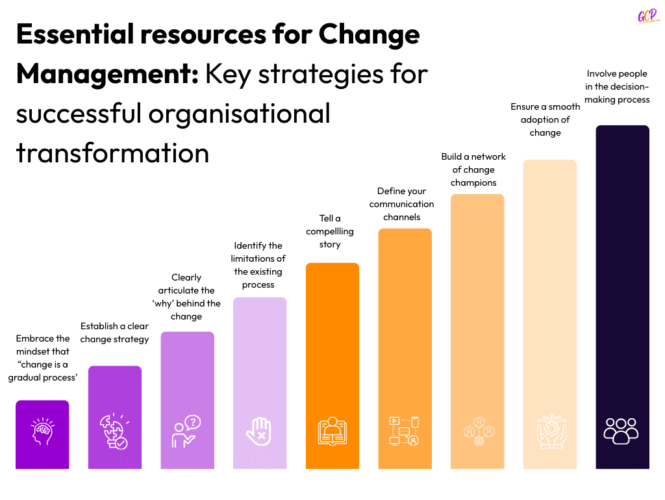Without a clearly defined and well-structured plan that outlines the changes to be made, the methodologies for execution, and the expected timelines, your efforts may lack the direction needed to transform ideas into successful outcomes.
Moreover, in the absence of a comprehensive plan, individuals are left without a shared understanding of the rationale behind the proposed change-often resulting in resistance to the new vision. While short-term wins may occur, they are unlikely to be sustained if the process is driven by sporadic efforts that fail to bring about meaningful, lasting change.
1. Embrace the Mindset that ‘Change is a Gradual Process’
Approaching change with realistic expectations from the outset lays the foundation for effective implementation. By viewing change as a journey rather than a single event, leaders can develop a practical timeline that allows the change management team to introduce new initiatives in manageable phases. Allowing adequate time for individuals to adjust ensures smoother adaptation and fosters engagement.
2. Establish a Clear Change Schedule
A well-balanced schedule maintains momentum without overwhelming or disengaging stakeholders. It’s important to allocate sufficient time for communicating and reinforcing the change vision while progressing with phased implementation.
We advise against phasing out legacy processes immediately following the launch of a new initiative. Instead, delay full decommissioning until the majority of users have successfully adopted the new solution. This is especially important in the case of digital transformation, where retiring legacy systems too early can result in data loss or disruption. Ensuring full transition before withdrawal supports continuity and confidence in the process.
3. Clearly Articulate the ‘Why’ Behind the Change
One of the most essential practices in effective change management is openly communicating the reason behind the transformation. When the ‘why’ is not articulated, people often view change as a top-down decision made solely for organisational gain, which breeds resistance.
By explaining the rationale, you address uncertainty and encourage buy-in. Sharing this insight demonstrates that the change is thoughtful and intentional-not arbitrary.
Here are two ways to do this:
a. Use Data to Justify the Change:
Leverage internal or external data to validate the initiative. For example, show how a similar change led to a 20% increase in productivity in another organisation. Or point to internal figures, such as a notable rise in employee sick leave, and explain how the new strategy aims to reduce burnout and enhance satisfaction.
b. Reflect Employee Feedback:
Draw from real employee experiences to shape and justify the initiative. If burnout has been flagged by team leaders and staff, explain how a new capacity planning tool will help manage workload more effectively. This shows your people that their voices were heard-and that the change is being made for them, not to them.
Need support crafting the message? We’re here to help-join us and let’s shape the journey together.
4. Identify the Limitations of Existing Processes
Pinpointing current inefficiencies not only strengthens the case for change, but also helps secure internal advocates. When people see that the proposed change directly addresses their pain points-what we call ‘dissatisfiers’-they’re more likely to support it.
Create a side-by-side comparison or cheat sheet listing limitations of the current approach alongside the benefits of the new one. This practical tool becomes a persuasive asset for communicating value at every stage of the change process.
5. Tell a Compelling Story
The clearer and more engaging your narrative, the easier it is to rally support. Use storytelling to build emotional resonance and demonstrate the real-life impact of the change.
For instance, when launching a new software tool, ask the provider to share case studies or success stories from other organisations. Real-world examples go beyond dry metrics-they show tangible improvements and make the benefits relatable to your teams.
6. Identify and Allocate Resources for Change Management
A key part of any successful initiative lies in identifying and preparing the resources for change management.
These resources may include:
People: Define roles clearly. Which leaders or teams are responsible for which parts of the change? What are their responsibilities and timelines?
Materials: This includes change collateral like explainer videos, how-to guides, cheat sheets, FAQs, and success stories. Whether sourced externally or created in-house, identify who is responsible for developing or distributing them.
Time: Don’t underestimate the time needed for answering questions, running training, and holding one-to-one conversations to resolve individual concerns. Meaningful engagement takes time-and should be factored into your plan from the start.
7. Define Your Communication Channels
Strategic communication is an essential resource for change management. Define which channels will be used, and for what purpose.
Examples may include:
Company-wide email updates
Team-specific communications
Slack or MS Teams
Internal intranet platforms
Ensure each channel has a defined purpose-whether that’s delivering updates, inviting feedback, or celebrating success stories. Consistency across these platforms ensures all teams receive the right messages at the right time.
8. Build a Network of Change Champions
Create a pilot group-or change champions-who are enthusiastic about the initiative. These individuals should be early adopters, ideally from different departments, who can test the process and offer constructive feedback.
In the context of a new tool, start with a team that enjoys trialling new systems. Have them document their experiences and results, then use their insights to inspire and support wider adoption across the organisation.
You might also identify individuals across departments who can run micro-training sessions or workshops, further enhancing peer-to-peer learning.
9. Ensure Smooth Adoption of Change
Employees are naturally resistant to change that disrupts their routines or demands new skills. Ease this transition by choosing user-friendly tools that integrate with existing systems, reducing the burden on staff and minimising workflow friction.
Provide helpful resources in various formats to meet diverse learning preferences-such as step-by-step PDFs and short explainer videos. Find these on our Good Change People Instagram & LinkedIn.
Ask your change champions to share their tips, use cases, and results-so others can learn from familiar, trusted peers.
10. Involve People in the Decision-Making Process
Inclusion is a powerful way to drive engagement. Involving employees early shows that their input is valued and that the change isn’t just about organisational goals-it’s about people.
In digital transformation, this could mean asking for tool suggestions or inviting staff to vote on options. Involve them in shaping the implementation plan, from training formats to rollout timelines.
This approach mirrors the open-source model of change, where employee feedback directly informs strategy. Research from Gartner shows this participative method can boost the likelihood of success by up to 22%, and increase the chances of lasting impact by 58%, compared to purely top-down approaches.





